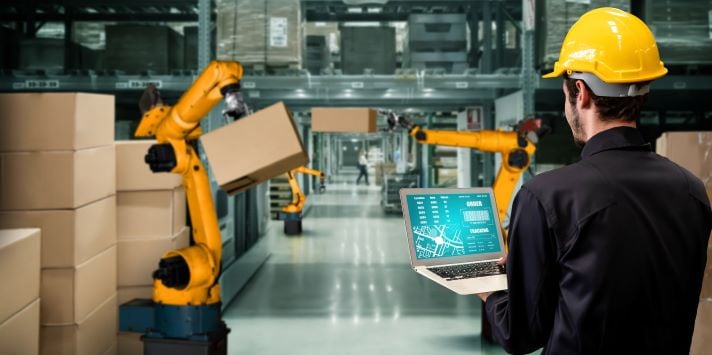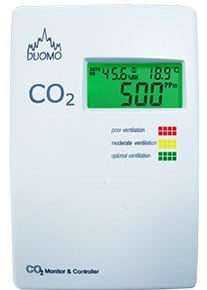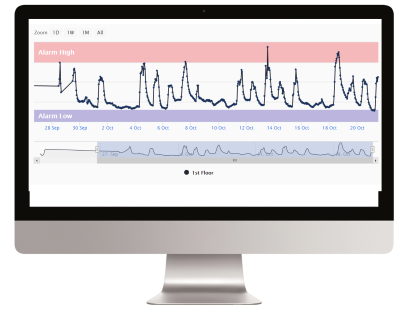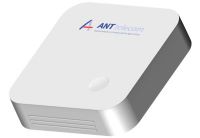
If you work in facility management or health and safety and it is one of your many tasks to ensure that the premises is safe and comfortable for staff and visitors, you might be interested to learn how IOT technology can help you improve air quality and therefore reduce the risk of Covid transmission.
It’s widely accepted that by keeping areas well ventilated helps to reduce viruses from spreading. There are two main methods for doing this. By simply opening windows and doors and, or, through mechanical means using ventilation systems that bring in fresh air from outside.
During warmer months keeping windows and doors open is less of an issue. However, in winter it can make conditions cold and unpleasant to work in, even with the heating on.
Measuring Air Quality with CO2 monitors
It isn’t possible to detect whether Covid is present in the air or a room. However, it is possible to measure how good or bad the air is. This is helpful to know because this will tell you how easily viruses will transmit from person to person. Areas that are well ventilated will quickly disperse the airborne particles that carry the virus. Whereas, the opposite occurs in rooms that are stuffy, making it far more transmissible.
possible to measure how good or bad the air is. This is helpful to know because this will tell you how easily viruses will transmit from person to person. Areas that are well ventilated will quickly disperse the airborne particles that carry the virus. Whereas, the opposite occurs in rooms that are stuffy, making it far more transmissible.
Air quality can be easily and cost effectively measured using CO2 monitors and sensors. This technology is widely available but before rushing out and spending money, it is important to understand how to use it and how it helps.
Monitors like the one shown in the picture above will tell you how much CO2 is present at that precise moment. However, CO2 levels change depending on the number of people present and how well the room is ventilated, which means spot checks must be taken throughout the course of the day to get a clear picture whether there is a problem or not.
Improve Air Quality
Once you have your measurements, you are in a far better position to improve the situation. This might mean opening windows to let fresh air in or closing them slightly if air quality is generally good but conditions cold and uncomfortable. You may decide to keep the windows ajar the full day or keep them fully open for 30 minutes every 2 hours – but whatever method you adopt it is important to make spot checks throughout the day and record the results so you can see what is and isn’t working.
Recording Data Manually
As the saying goes “you can’t improve what you don’t measure”. However, taking CO2 measurements a few times a day and recording the data is likely to become tiresome on a long term basis, especially if there are multiple rooms that require monitoring. And though we all hope to see an end to Covid shortly, the recent flare up with the Omicron variant is a brutal reminder that the pandemic still has a long way to run in the UK.
Automated CO2 Monitoring and Data Recording
Rather than implementing costly manually processes our Automated Monitoring Solution can help by collecting the data and presenting it in a dashboard for you to review from any PC, Laptop and Smartphone.
can help by collecting the data and presenting it in a dashboard for you to review from any PC, Laptop and Smartphone.
As you can see in the chart, CO2 levels are collected at regular intervals helping to present a much clearer picture on how levels change throughout the course of the day as people move in and out of the room. Collecting this data 24/7 helps to show a pattern making it far easier for you to improve conditions. Furthermore, each change you make you can easily see how it affects CO2 levels and whether further adjustments need to be taken.
Thresholds can also be set to notify specific personnel (via SMS, phone call and email) when levels have been breached and floor plans can be loaded so users can visually see where the sensors are located and where any alarms are coming from.
Once the conditions are right, you have documented evidence that you can show to staff, visitors or both, to help motivate and encourage them to return.
Wireless Sensors
Rather than using monitors with a display that need power, our CO2 Sensor is wireless making it easy and cost effective to install. Simply peel back the adhesive tape and stick to the wall at head height, away from doors, windows and air vents. Our sensor has no display and therefore won’t distract staff from their work.
wireless making it easy and cost effective to install. Simply peel back the adhesive tape and stick to the wall at head height, away from doors, windows and air vents. Our sensor has no display and therefore won’t distract staff from their work.
As well as CO2, other conditions and equipment can be easily monitored to help improve safety and compliance for example; the storing of food, drugs and vaccines at the correct refrigerated temperatures, energy usage, water safety (e.g. preventing legionella) and leak or gas detection.
Summary
If you have a responsibility to make your premises safe and comfortable for staff and visitors, it is so important to have accurate and up-to-date information to help you implement a process to improve air quality.
Though CO2 monitors are cheap they won’t give you the information you need to improve conditions, without spending valuable time and energy collecting the data.
Alternatively, our Automated IOT Monitoring system offers a far more reliable, accurate and cost effective solution to measuring CO2 levels. Data is collected automatically (from all CO2 sensors) and presented centrally, right at your fingertips, making it much easier for you to not only set up a process to improve ventilation but one that you can continuously measure and improve for the safety and comfort of your staff and customers.
For more information or to see a demo of our solution get in touch.



